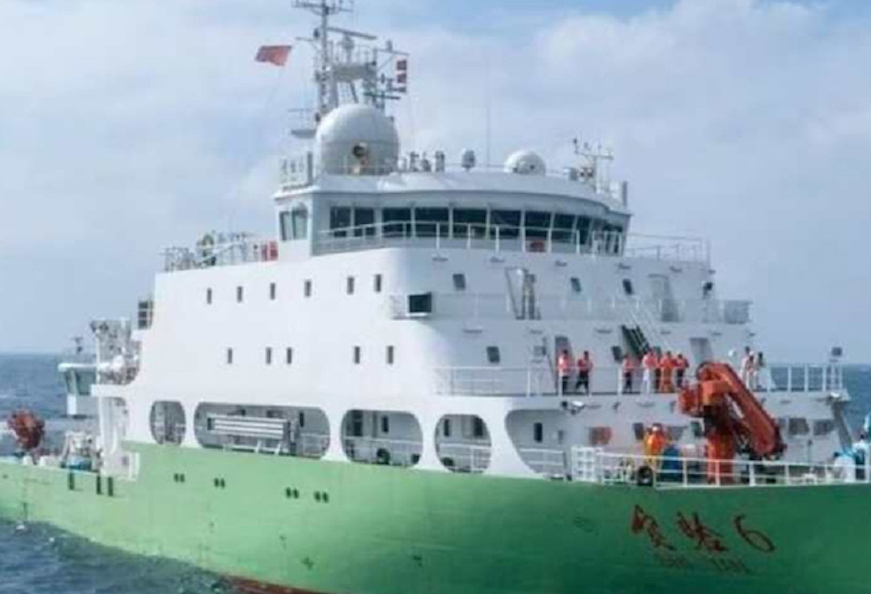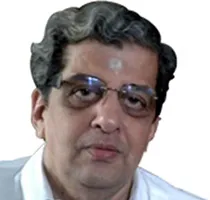-
CENTRES
Progammes & Centres
Location
The docking of Chinese vessel Shi Yan-6 has made Sri Lanka walk a delicate tight rope between its relations with India on the one hand and China on the other.

The last-minute postponement of Indian defence minister Rajnath Singh’s Sri Lanka visit, scheduled for 2-3 September, owing to ‘unavoidable circumstances’, coupled with the anticipated arrival of a second Chinese ‘spy ship’ this year for docking in Colombo Port in October, may have—together—muddled the host-nation’s strategic equations with the two Asian giants, when it can ill-afford the same. If anything, Sri Lanka needs both India and China on board, along with a host of other nations—like another Asian power like Japan and a Western ally, starting with the United States (US) of course—to set its unstable economy in order. It must have all this before it can, if at all, afford to take strategic positions on the affairs of the Indian Ocean and the continuing India-China conundrum.
The visit holds significance because it takes place in the context of Sri Lanka and India having agreed at the highest level to implement connectivity projects including a land bridge and the interconnection of the national grids.
Ahead of the visit, India had touted it as an ‘important landmark’ in bilateral defence cooperation. Accordingly, Rajnath Singh was to have met President Ranil Wickremesinghe, who is also the nation’s defence minister under the Constitution, and Prime Minister Dinesh Gunawardena—where they would have reviewed all aspects of bilateral defence ties. “This visit … will reiterate India’s continued commitment in furthering the existing warm and friendly relations with Sri Lanka. It will be an important landmark in building the strong bonds of friendship between the two countries,” a defence ministry news release had said in New Delhi at the time.
“The entire gamut of India’s defence ties with Sri Lanka will be reviewed during the meetings. The Raksha Mantri (defence minister) will also visit Nuwara Elia in central Sri Lanka and Trincomalee, which is located in the eastern part of the country,” the ministry had said further. According to a Colombo daily, Daily Mirror, Rajnath Singh was to ‘travel to Trincomalee where India has embarked on strategic investments with the final aim of establishing a pipeline linking the two countries for the transfer of petroleum products…. The visit holds significance because it takes place in the context of Sri Lanka and India having agreed at the highest level to implement connectivity projects including a land bridge and the interconnection of the national grids.’ As Sri Lankan media reports pointed out, in January 2022, India had signed up to jointly re-develop the ‘oil tanker farms’ of Second World War vintage.
Likewise, Singh, as per a Hindustan Times report, was also supposed to host the Sri Lankan leadership on board INS Delhi, the Indian Navy’s first indigenously designed and built guided missile destroyer, which was on a two-day visit. “Further, as part of India’s ‘Arogya Maitri’ initiative to provide quality medical supplies to friendly countries, the Raksha Mantri will hand over state-of-the-art medical bricks that have been indigenously developed under project BHISHM (Bharat Health Initiative for Sahyog Hita and Maitri),” the Indian Navy had said in a statement.
While the ministerial visit was postponed and will take place at a mutually-convenient time, according to an Indian High Commission Press statement in Colombo, the navy vessel departed as per schedule. Before departure, INS Delhi did conduct a successful Passage Exercise (PASSEX) with SLNS Vijayabahu, involving communication training and tactical manoeuvring training exercises. Incidentally, the High Commission statement did not mention either a ministerial visit to places outside Colombo, nor was there any reference to an on-board programme for the dignitaries.
Rajnath Singh’s visit itself and its last-minute postponement have both been attributed to India’s sensitivity to Colombo’s position/posturing on permitting a Chinese ‘spy ship’, the second in 12-plus months, to dock at one of its ports. The Sri Lankan defence ministry recently confirmed that they had received a Chinese request in this regard. The significant departure between the earlier and the current ship docking is that Yuan Wang-5 docked at China-controlled Hambantota Port in the nation’s southern-most edge while Shi Yan-6 is expected to arrive and halt at Colombo Port.
Rajnath Singh’s visit itself and its last-minute postponement have both been attributed to India’s sensitivity to Colombo’s position/posturing on permitting a Chinese ‘spy ship’, the second in 12-plus months, to dock at one of its ports. The Sri Lankan defence ministry recently confirmed that they had received a Chinese request in this regard.
Like the last time around, Beijing has denied that the new ship was on a spy mission, but has stated that it is instead part of a long-term ocean research expedition, aimed at locating the ruins of 15th century Chinese Admiral Zheng He’s sunken vessel. According to Sri Lankan reports, the bilateral agreement in this regard was signed by the then Mahinda Rajapaksa Government during the Sri Lanka visit of Chinese President Xi Jinping in 2014. Already three such surveys had been undertaken when present-day President Wickremesinghe was Prime Minister between 2015-19. This is thus the third visit by a Chinese ‘research vessel’ on a similar mission (excluding Yuan Wang-5), with at least one more remaining before the mission-agreement comes to a close in 2026. There are not many takers outside of the two countries for the Chinese submissions in the matter.
However, Colombo media reports, especially in The Island, still claimed Shi Yan-6 will engage in joint research with Sri Lanka’s National Aquatic Research and Development Agency (NARA), after the original agreement has been amended twice. Shi Yan-6 will be involved in the fourth of the total five expeditions to be completed by 2026. Incidentally, a ship-wreck was, after all, found during one of the three earlier surveys, but they were later identified as belonging to a Norwegian vessel, The Island report said. As per these reports in The Island, the two sides have agreed to establish a joint research centre to further expand the studies and widen the area of ‘operations’. The scheduled fourth survey has attracted public attention due to India expressing concerns over Chinese ship visits though the three previous surveys took place without controversy. Sources told The Island that the issue was under consideration at the highest level though, at the same time, the Wickremesinghe Government was also known to be reviewing the Zheng He project as a whole.
According to these reports, it was still unclear if the Sri Lankan signatories had obtained the mandatory clearance from the Attorney-General’s office. They also pointed out how France too was interested in setting up a research facility and how Colombo was keen that it should be set up in Trincomalee, and not with the Kotelawala Defence University (KDU) closer to the capital. Incidentally, a recent visit of a French spy ship to Colombo Harbour went mostly unnoticed.
Colombo’s dispensation is yet to make its stand clear on allowing the Chinese vessel to dock in October. A section of the Indian media has since claimed that the cancellation/postponement of the defence minister’s visit was a ‘subtle way’ for New Delhi to send out a message to Colombo on la affaire Shi Yan-6. However, over the past several months, India and Sri Lanka have worked together in multiple layers of defence cooperation.
For instance, Indian Air Force chief, Air Chief Marshal V R Chaudhari was on an official visit to Sri Lanka in May, where he donated propellers of AN-32 transport aircraft to his Sri Lankan Air Force counterpart. This was followed on Independence Day, 15 August, by Indian High Commissioner Gopal Bagalay handing over the second of two requested for Dornier fixed-wing reconnaissance aircraft of the Indian Navy, which would “exponentially increase the surveillance capability of Sri Lanka and would be a force multiplier for the Sri Lanka Air Force,” as the Indian High Commission said in a statement. Sri Lankan media reports also reported, quoting their defence ministry, how, last year, the two South Asian, Indian Ocean neighbours, had signed two pacts for Colombo to receive a floating dock facility for free, though neither side had announced it officially at any time.
In June this year, taking bilateral defence and security cooperation to a higher level, the Indian High Commission organised the first India-Sri Lanka Defence Seminar and Exhibition in Colombo to “promote and identify’ newer areas of cooperation and collaboration between the two countries in the defence sector as reported by The Hindu, based in Chennai. At another event, this one to mark the golden jubilee of India’s National Defence College (NDC) and the Sri Lanka Armed Forces in Colombo recently, Indian High Commissioner Gopal Baglay reiterated New Delhi’s commitment to Sri Lanka’s capacity-building endeavours in line with India’s ‘Neighbourhood First Policy’. He pointed out how training engagements between the two armed forces had instilled a spirit of brotherhood and inter-operability amongst the services and formed the foundation of their strong bonds.
Referring to the ‘diplomatic power games’ involving India, China, and Sri Lanka, the Colombo-based Daily Mirror, in an editorial, pointed out how India extended a US$4-billion aid package and also readily underwrote the nation’s US$2.9-billion debt to the International Monetary Fund (IMF). China, on the other hand, remained the biggest bilateral creditor, accounting for US$7.4 billion—or nearly a fifth—of the nation’s public external debt. China was only offering new loans to repay the existing one; though, subsequently, it was agreed to reschedule the loan, ‘to please other international creditors and make our application for an IMF facility possible’.
The editorial referred to the Shi Yan-6 episode and noted how China claimed it was only a research vessel but ‘our giant neighbour’ India has raised objections to the entry of this vessel. “What is sad, however, is that India, despite knowing Lanka’s delicate situation because of our economic plight and indebted situation, expects this country to deny the Chinese vessel entry into our ports,” the editorial said, adding, “This is not the first time India has made such demands from the Sri Lankan government.”
However, the editorial added that Sri Lanka’s ‘present leadership was able to navigate these troubled waters successfully at that time’ and expressed the hope that they ‘will be able to ride through the present crisis without treading on the corns of either Chinese or Indian toes as the goodwill of both countries are important to us’.
The views expressed above belong to the author(s). ORF research and analyses now available on Telegram! Click here to access our curated content — blogs, longforms and interviews.

N. Sathiya Moorthy is a policy analyst and commentator based in Chennai.
Read More +